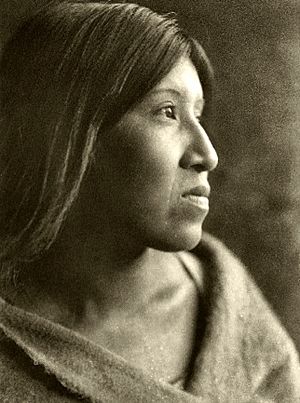Kizh facts for kids
The Kizh (pronounced Keech) are a group of Native American people. They are also known as the Mission Indians of San Gabriel. Long ago, most tribes in California were known by their village names, like Cucamonga or Pimuvungna. The name "Kizh" comes from a word that describes the willow houses they lived in. Early records from Mission Viejas called them "Kizheriños," meaning "The People of the Willow Houses."
In 1811, priests at Mission San Gabriel wrote down four different languages spoken by the people living there. Later, in 1982, a U.S. government report listed many villages where these people lived. Today, the Kizh Nation is one of the groups that identify as descendants of the original Gabrielino people.
In 1994, some Kizh descendants separated from another tribal council. They continued to call themselves "Tongva" for several years. Then, in 2010, they formed their own group called Los Indios de San Gabriel, Inc. The Kizh Nation is based in San Gabriel, California, and has about 500 members.
Contents
Names of the Kizh People
When Spanish people came to California, they gave names to the Native American groups based on the missions built on their land. The people near Mission San Gabriel Arcángel were called Gabrieleño, and those near Mission San Fernando Rey de España were called Fernandeño.
The name Tongva has also been used, but the Kizh Nation believes this name became popular later. They say it came from the notes of one researcher, C. Hart Merriam, in 1855. The Kizh Nation says their name, Kizh, comes from the earliest records. It refers to the houses they built from willow branches, reeds, and brush. Many researchers in the 1800s and early 1900s used the name Kizh. However, Tongva is still the most widely used name today.
What Does 'Tongva' Mean?
The word Tongva was written down by C. Hart Merriam in 1855. He learned it from several Native people, including a Gabrieleño woman named Mrs. James Rosemyre. She lived near Fort Tejon. Some believe that Merriam might have misunderstood her. Tribal members often referred to themselves by their village name, not a name for all tribes. It is thought that Mrs. Rosemyre might have been talking about her village, not a name for all the people.
According to Ernest Perez Teutimez Salas, a spokesperson for the Kizh Nation, the name Tongva became well-known in 1992. At that time, some non-Native people told the tribe they should use the name "Tongva" to help save a special spring in Santa Monica, California. The tribe agreed to use the name to protect the spring, which was saved under the name “Gabrieleño/Tongva Springs Foundation.”
Another researcher, E. Gary Stickel, found notes from John Peabody Harrington, who studied Southern California tribes. Harrington's notes suggest that the word tongva refers to places where the Gabrieleño people ground their seeds on rocks. These places are called "bedrock mortars" by archaeologists. They are rocks with hollows where Native Americans crushed acorns and other plants.
What Does 'Kizh' Mean?

According to Andrew Salas, the name Kizh (pronounced Keech) comes from the time when Mission San Gabriel was first built in 1771. The Native people who were made to help build the mission called themselves "Kizh." The Spanish changed this word to "Kichireños." The word Kizh means the houses they lived in, which were often dome-shaped and made from willow branches with thatched roofs.
The neighboring ʔívil̃uqaletem (Cahuilla) people called them Kisianos, meaning "people of the willow-brush houses." This is another possible source for the name Kizh. After the first mission was destroyed, the Spanish moved it and started calling the Kizh people "Gabrieleño."
Many important scholars used the name Kizh in their writings during the 1800s and early 1900s. These included Horatio Hale in 1846, Amiel Weeks Whipple in 1855, and A. L. Kroeber in 1907.
In 1875, H. C. Yarrow said he could not confirm the name Kizh at Mission San Gabriel. He reported that the Native people there called themselves Tobikhar. However, in 1900, David Prescott Barrows said that using Tobikhar was incorrect. He stated that these words were not used by the Native people themselves to describe their tribes. It is important to remember that in 1811, the missions recorded seven different languages, each often linked to a specific village.
What Does 'Gabrieleño' Mean?
The name Gabrieleño was given to the Native people around Mission San Gabriel Arcángel by the Spanish. It was not a name the people used for themselves. However, it is still part of the official names of many tribes today, either as "Gabrieleño" or "Gabrielino."
Because there is a disagreement among tribal groups about using the name Tongva, Gabrieleño has sometimes been used as a middle ground. For example, in 2017, when wooden statues were dedicated to the Native people in Ganesha Park in Pomona, California, there was a debate about whether to use Tongva or Kizh on the plaque. They eventually agreed to use Gabrieleño, even though it came from the Spanish colonizers.
See also
 In Spanish: Kizh (Kich) para niños
In Spanish: Kizh (Kich) para niños

